International Crisis: Iran, EU & USA-Israel Diplomatic Strategy Essay
VerifiedAdded on 2023/06/11
|10
|2663
|477
Essay
AI Summary
This essay examines the diplomatic strategies employed by Iran, the European Union, the United States, and Israel concerning Iran's nuclear program. It evaluates Iran's compliance with international treaties, particularly the Non-Proliferation Treaty (NPT), and addresses allegations of secret nuclear activities. The analysis includes a discussion of coercive diplomacy, focusing on the EU's efforts to limit Iran's nuclear ambitions and the impact of international coalitions like the P5+2. The paper explores the reasons behind the limited success of coercive diplomacy and assesses the legitimacy and effectiveness of the demands placed on Iran. Ultimately, the essay evaluates the EU's performance in engaging with Iran, highlighting both achievements and failures in preventing Iran from pursuing its complete fuel cycle activities.
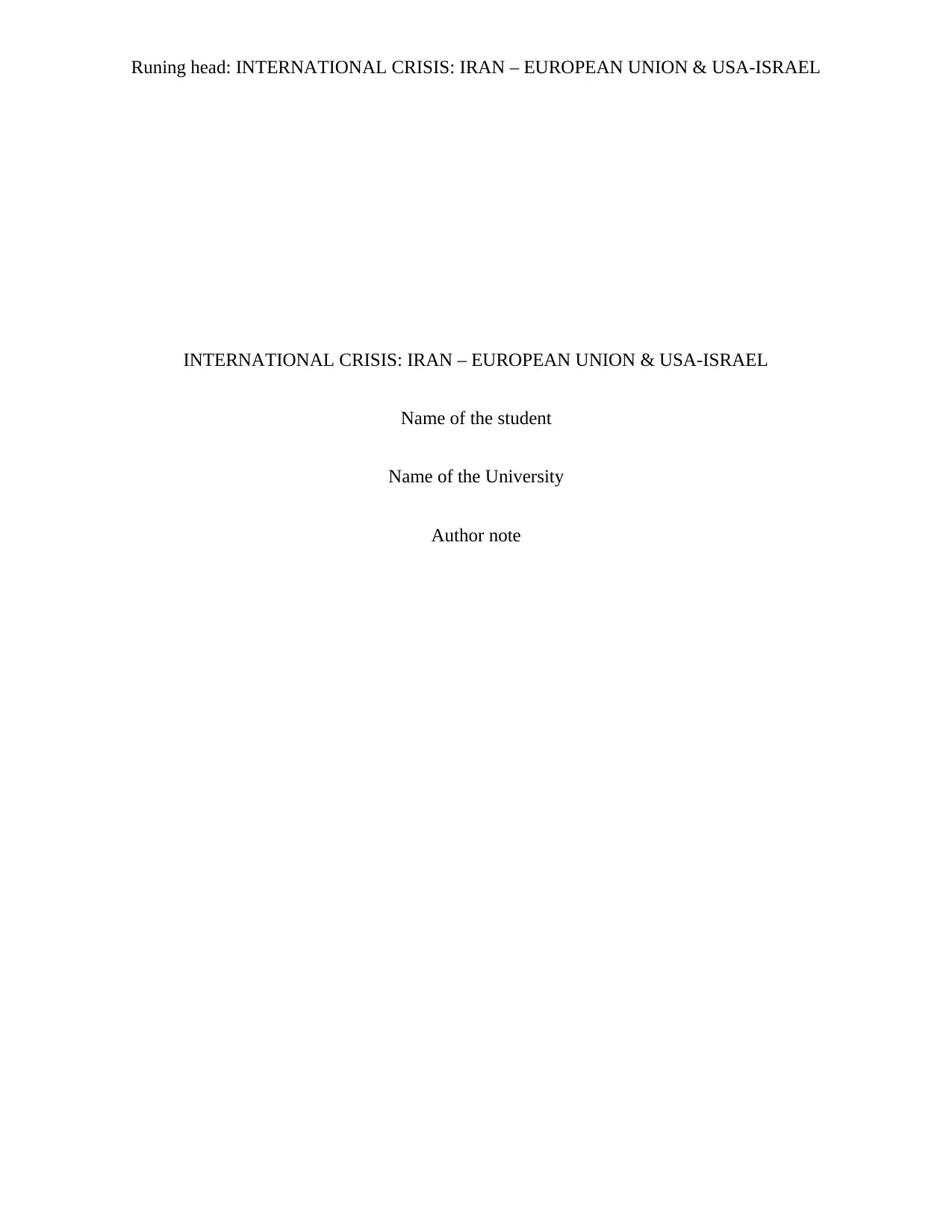
Runing head: INTERNATIONAL CRISIS: IRAN – EUROPEAN UNION & USA-ISRAEL
INTERNATIONAL CRISIS: IRAN – EUROPEAN UNION & USA-ISRAEL
Name of the student
Name of the University
Author note
INTERNATIONAL CRISIS: IRAN – EUROPEAN UNION & USA-ISRAEL
Name of the student
Name of the University
Author note
Paraphrase This Document
Need a fresh take? Get an instant paraphrase of this document with our AI Paraphraser
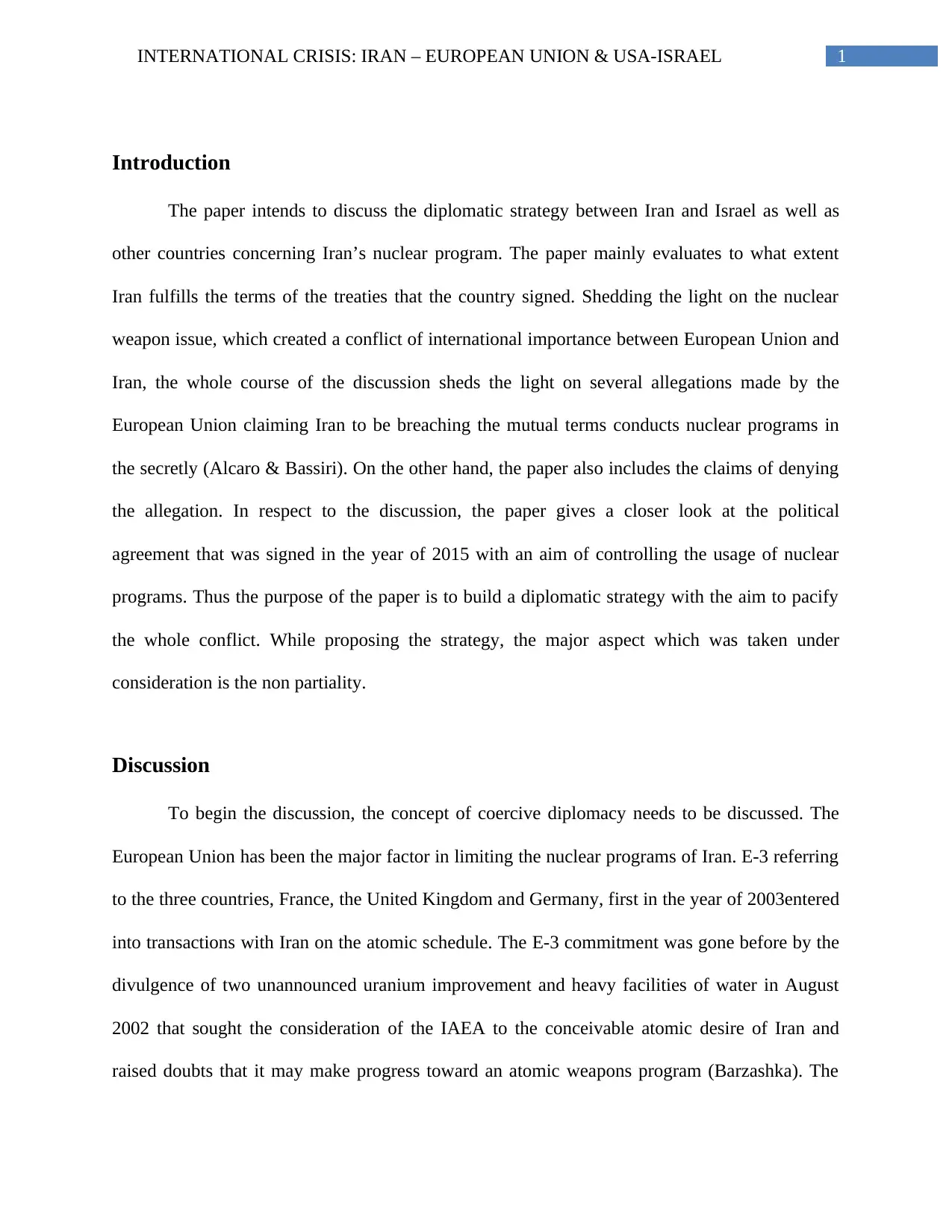
1INTERNATIONAL CRISIS: IRAN – EUROPEAN UNION & USA-ISRAEL
Introduction
The paper intends to discuss the diplomatic strategy between Iran and Israel as well as
other countries concerning Iran’s nuclear program. The paper mainly evaluates to what extent
Iran fulfills the terms of the treaties that the country signed. Shedding the light on the nuclear
weapon issue, which created a conflict of international importance between European Union and
Iran, the whole course of the discussion sheds the light on several allegations made by the
European Union claiming Iran to be breaching the mutual terms conducts nuclear programs in
the secretly (Alcaro & Bassiri). On the other hand, the paper also includes the claims of denying
the allegation. In respect to the discussion, the paper gives a closer look at the political
agreement that was signed in the year of 2015 with an aim of controlling the usage of nuclear
programs. Thus the purpose of the paper is to build a diplomatic strategy with the aim to pacify
the whole conflict. While proposing the strategy, the major aspect which was taken under
consideration is the non partiality.
Discussion
To begin the discussion, the concept of coercive diplomacy needs to be discussed. The
European Union has been the major factor in limiting the nuclear programs of Iran. E-3 referring
to the three countries, France, the United Kingdom and Germany, first in the year of 2003entered
into transactions with Iran on the atomic schedule. The E-3 commitment was gone before by the
divulgence of two unannounced uranium improvement and heavy facilities of water in August
2002 that sought the consideration of the IAEA to the conceivable atomic desire of Iran and
raised doubts that it may make progress toward an atomic weapons program (Barzashka). The
Introduction
The paper intends to discuss the diplomatic strategy between Iran and Israel as well as
other countries concerning Iran’s nuclear program. The paper mainly evaluates to what extent
Iran fulfills the terms of the treaties that the country signed. Shedding the light on the nuclear
weapon issue, which created a conflict of international importance between European Union and
Iran, the whole course of the discussion sheds the light on several allegations made by the
European Union claiming Iran to be breaching the mutual terms conducts nuclear programs in
the secretly (Alcaro & Bassiri). On the other hand, the paper also includes the claims of denying
the allegation. In respect to the discussion, the paper gives a closer look at the political
agreement that was signed in the year of 2015 with an aim of controlling the usage of nuclear
programs. Thus the purpose of the paper is to build a diplomatic strategy with the aim to pacify
the whole conflict. While proposing the strategy, the major aspect which was taken under
consideration is the non partiality.
Discussion
To begin the discussion, the concept of coercive diplomacy needs to be discussed. The
European Union has been the major factor in limiting the nuclear programs of Iran. E-3 referring
to the three countries, France, the United Kingdom and Germany, first in the year of 2003entered
into transactions with Iran on the atomic schedule. The E-3 commitment was gone before by the
divulgence of two unannounced uranium improvement and heavy facilities of water in August
2002 that sought the consideration of the IAEA to the conceivable atomic desire of Iran and
raised doubts that it may make progress toward an atomic weapons program (Barzashka). The
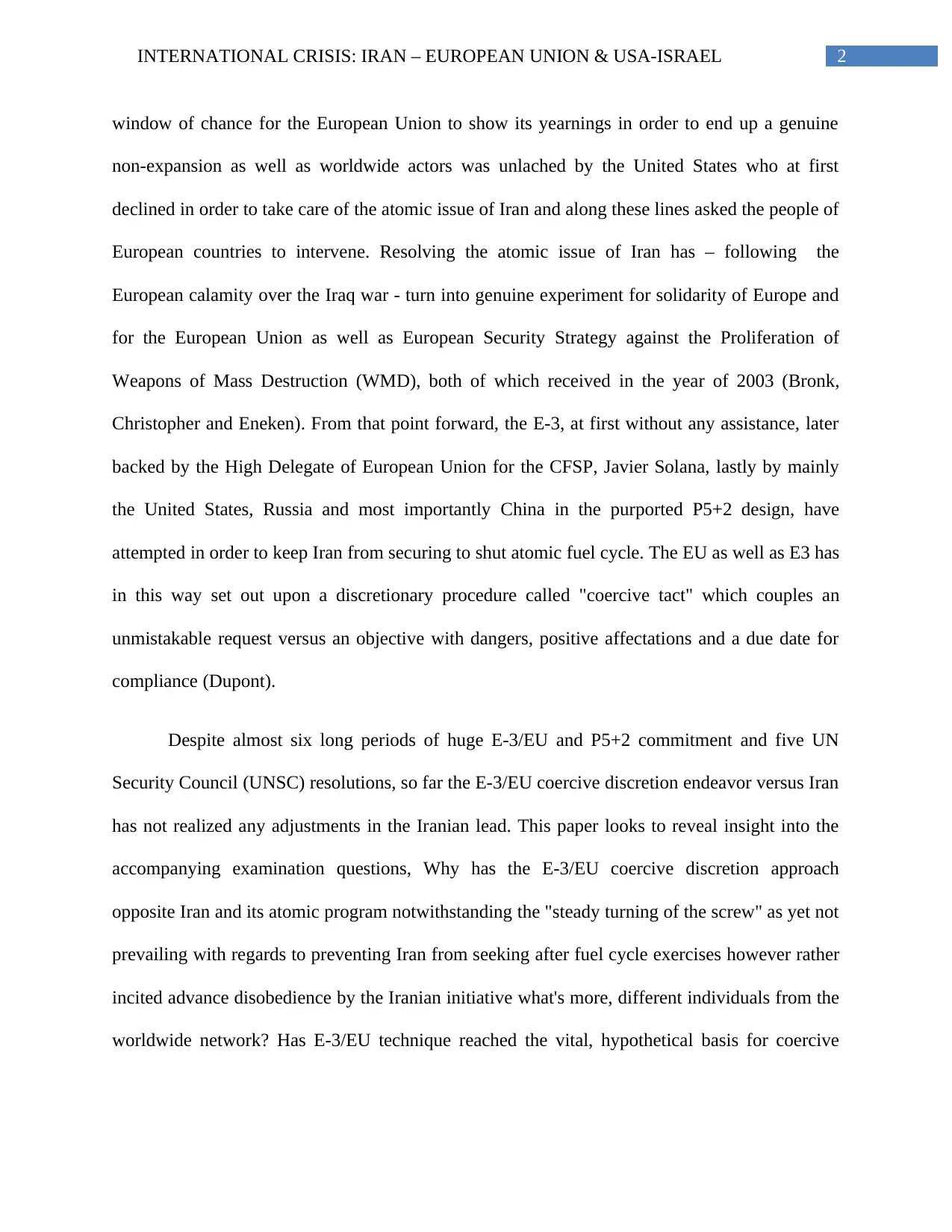
2INTERNATIONAL CRISIS: IRAN – EUROPEAN UNION & USA-ISRAEL
window of chance for the European Union to show its yearnings in order to end up a genuine
non-expansion as well as worldwide actors was unlached by the United States who at first
declined in order to take care of the atomic issue of Iran and along these lines asked the people of
European countries to intervene. Resolving the atomic issue of Iran has – following the
European calamity over the Iraq war - turn into genuine experiment for solidarity of Europe and
for the European Union as well as European Security Strategy against the Proliferation of
Weapons of Mass Destruction (WMD), both of which received in the year of 2003 (Bronk,
Christopher and Eneken). From that point forward, the E-3, at first without any assistance, later
backed by the High Delegate of European Union for the CFSP, Javier Solana, lastly by mainly
the United States, Russia and most importantly China in the purported P5+2 design, have
attempted in order to keep Iran from securing to shut atomic fuel cycle. The EU as well as E3 has
in this way set out upon a discretionary procedure called "coercive tact" which couples an
unmistakable request versus an objective with dangers, positive affectations and a due date for
compliance (Dupont).
Despite almost six long periods of huge E-3/EU and P5+2 commitment and five UN
Security Council (UNSC) resolutions, so far the E-3/EU coercive discretion endeavor versus Iran
has not realized any adjustments in the Iranian lead. This paper looks to reveal insight into the
accompanying examination questions, Why has the E-3/EU coercive discretion approach
opposite Iran and its atomic program notwithstanding the "steady turning of the screw" as yet not
prevailing with regards to preventing Iran from seeking after fuel cycle exercises however rather
incited advance disobedience by the Iranian initiative what's more, different individuals from the
worldwide network? Has E-3/EU technique reached the vital, hypothetical basis for coercive
window of chance for the European Union to show its yearnings in order to end up a genuine
non-expansion as well as worldwide actors was unlached by the United States who at first
declined in order to take care of the atomic issue of Iran and along these lines asked the people of
European countries to intervene. Resolving the atomic issue of Iran has – following the
European calamity over the Iraq war - turn into genuine experiment for solidarity of Europe and
for the European Union as well as European Security Strategy against the Proliferation of
Weapons of Mass Destruction (WMD), both of which received in the year of 2003 (Bronk,
Christopher and Eneken). From that point forward, the E-3, at first without any assistance, later
backed by the High Delegate of European Union for the CFSP, Javier Solana, lastly by mainly
the United States, Russia and most importantly China in the purported P5+2 design, have
attempted in order to keep Iran from securing to shut atomic fuel cycle. The EU as well as E3 has
in this way set out upon a discretionary procedure called "coercive tact" which couples an
unmistakable request versus an objective with dangers, positive affectations and a due date for
compliance (Dupont).
Despite almost six long periods of huge E-3/EU and P5+2 commitment and five UN
Security Council (UNSC) resolutions, so far the E-3/EU coercive discretion endeavor versus Iran
has not realized any adjustments in the Iranian lead. This paper looks to reveal insight into the
accompanying examination questions, Why has the E-3/EU coercive discretion approach
opposite Iran and its atomic program notwithstanding the "steady turning of the screw" as yet not
prevailing with regards to preventing Iran from seeking after fuel cycle exercises however rather
incited advance disobedience by the Iranian initiative what's more, different individuals from the
worldwide network? Has E-3/EU technique reached the vital, hypothetical basis for coercive
⊘ This is a preview!⊘
Do you want full access?
Subscribe today to unlock all pages.

Trusted by 1+ million students worldwide
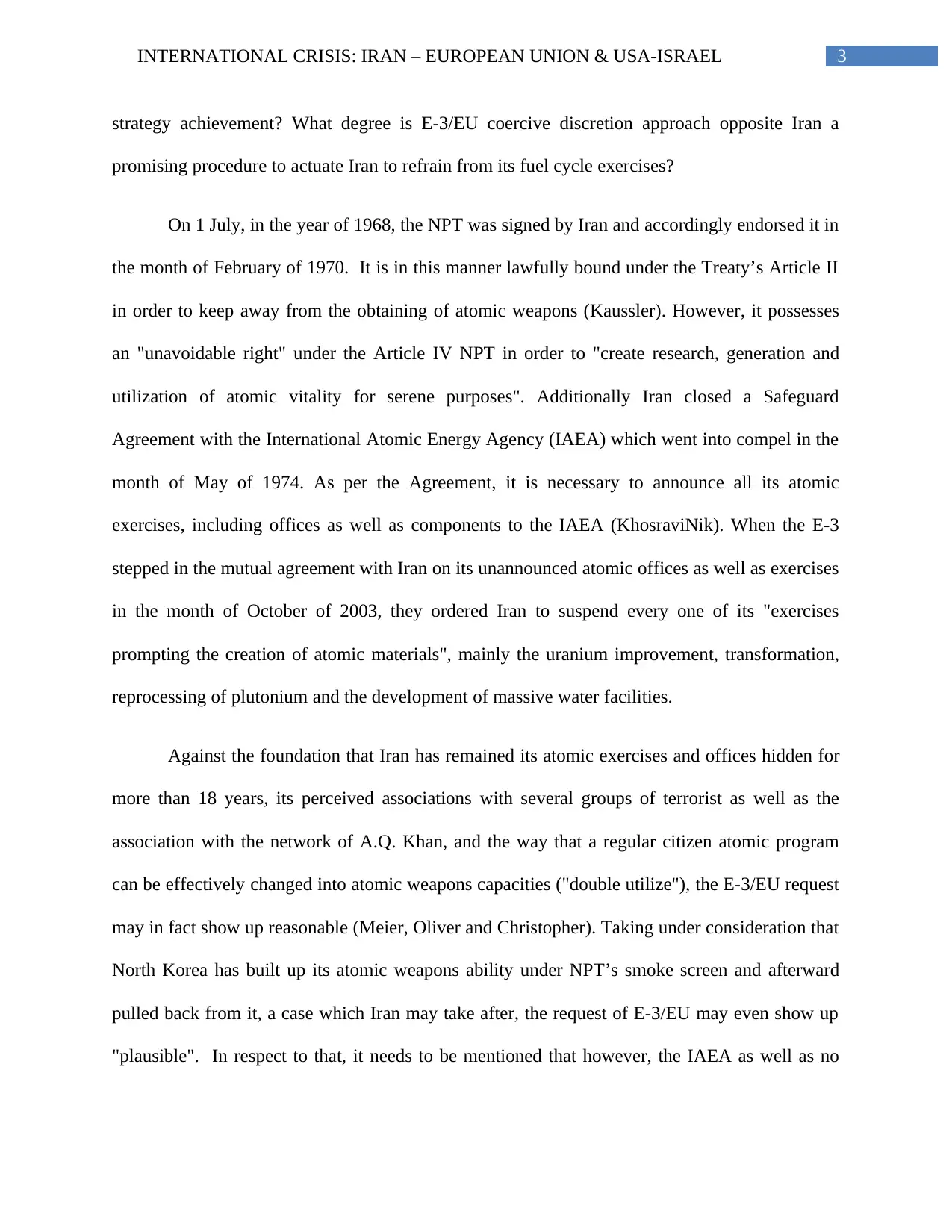
3INTERNATIONAL CRISIS: IRAN – EUROPEAN UNION & USA-ISRAEL
strategy achievement? What degree is E-3/EU coercive discretion approach opposite Iran a
promising procedure to actuate Iran to refrain from its fuel cycle exercises?
On 1 July, in the year of 1968, the NPT was signed by Iran and accordingly endorsed it in
the month of February of 1970. It is in this manner lawfully bound under the Treaty’s Article II
in order to keep away from the obtaining of atomic weapons (Kaussler). However, it possesses
an "unavoidable right" under the Article IV NPT in order to "create research, generation and
utilization of atomic vitality for serene purposes". Additionally Iran closed a Safeguard
Agreement with the International Atomic Energy Agency (IAEA) which went into compel in the
month of May of 1974. As per the Agreement, it is necessary to announce all its atomic
exercises, including offices as well as components to the IAEA (KhosraviNik). When the E-3
stepped in the mutual agreement with Iran on its unannounced atomic offices as well as exercises
in the month of October of 2003, they ordered Iran to suspend every one of its "exercises
prompting the creation of atomic materials", mainly the uranium improvement, transformation,
reprocessing of plutonium and the development of massive water facilities.
Against the foundation that Iran has remained its atomic exercises and offices hidden for
more than 18 years, its perceived associations with several groups of terrorist as well as the
association with the network of A.Q. Khan, and the way that a regular citizen atomic program
can be effectively changed into atomic weapons capacities ("double utilize"), the E-3/EU request
may in fact show up reasonable (Meier, Oliver and Christopher). Taking under consideration that
North Korea has built up its atomic weapons ability under NPT’s smoke screen and afterward
pulled back from it, a case which Iran may take after, the request of E-3/EU may even show up
"plausible". In respect to that, it needs to be mentioned that however, the IAEA as well as no
strategy achievement? What degree is E-3/EU coercive discretion approach opposite Iran a
promising procedure to actuate Iran to refrain from its fuel cycle exercises?
On 1 July, in the year of 1968, the NPT was signed by Iran and accordingly endorsed it in
the month of February of 1970. It is in this manner lawfully bound under the Treaty’s Article II
in order to keep away from the obtaining of atomic weapons (Kaussler). However, it possesses
an "unavoidable right" under the Article IV NPT in order to "create research, generation and
utilization of atomic vitality for serene purposes". Additionally Iran closed a Safeguard
Agreement with the International Atomic Energy Agency (IAEA) which went into compel in the
month of May of 1974. As per the Agreement, it is necessary to announce all its atomic
exercises, including offices as well as components to the IAEA (KhosraviNik). When the E-3
stepped in the mutual agreement with Iran on its unannounced atomic offices as well as exercises
in the month of October of 2003, they ordered Iran to suspend every one of its "exercises
prompting the creation of atomic materials", mainly the uranium improvement, transformation,
reprocessing of plutonium and the development of massive water facilities.
Against the foundation that Iran has remained its atomic exercises and offices hidden for
more than 18 years, its perceived associations with several groups of terrorist as well as the
association with the network of A.Q. Khan, and the way that a regular citizen atomic program
can be effectively changed into atomic weapons capacities ("double utilize"), the E-3/EU request
may in fact show up reasonable (Meier, Oliver and Christopher). Taking under consideration that
North Korea has built up its atomic weapons ability under NPT’s smoke screen and afterward
pulled back from it, a case which Iran may take after, the request of E-3/EU may even show up
"plausible". In respect to that, it needs to be mentioned that however, the IAEA as well as no
Paraphrase This Document
Need a fresh take? Get an instant paraphrase of this document with our AI Paraphraser
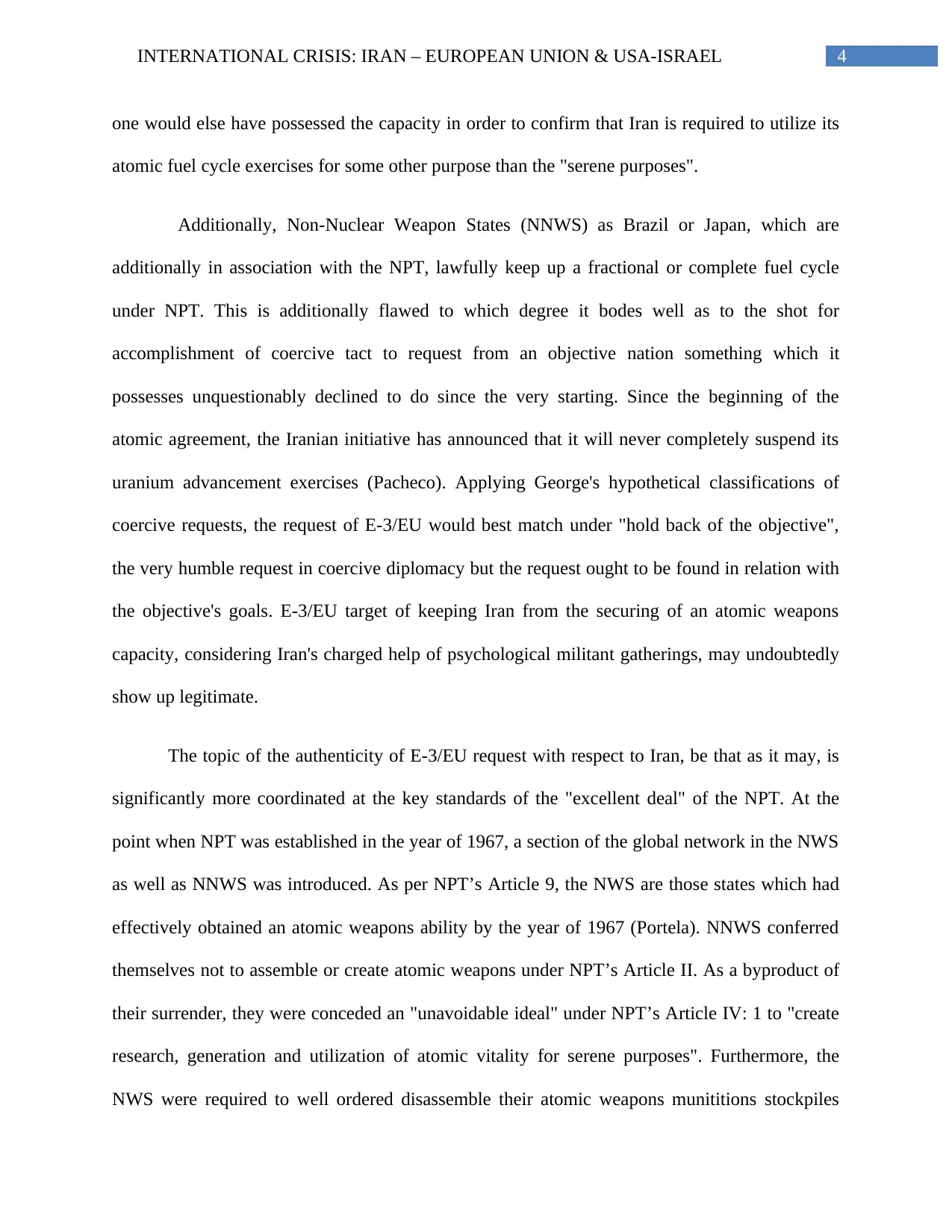
4INTERNATIONAL CRISIS: IRAN – EUROPEAN UNION & USA-ISRAEL
one would else have possessed the capacity in order to confirm that Iran is required to utilize its
atomic fuel cycle exercises for some other purpose than the "serene purposes".
Additionally, Non-Nuclear Weapon States (NNWS) as Brazil or Japan, which are
additionally in association with the NPT, lawfully keep up a fractional or complete fuel cycle
under NPT. This is additionally flawed to which degree it bodes well as to the shot for
accomplishment of coercive tact to request from an objective nation something which it
possesses unquestionably declined to do since the very starting. Since the beginning of the
atomic agreement, the Iranian initiative has announced that it will never completely suspend its
uranium advancement exercises (Pacheco). Applying George's hypothetical classifications of
coercive requests, the request of E-3/EU would best match under "hold back of the objective",
the very humble request in coercive diplomacy but the request ought to be found in relation with
the objective's goals. E-3/EU target of keeping Iran from the securing of an atomic weapons
capacity, considering Iran's charged help of psychological militant gatherings, may undoubtedly
show up legitimate.
The topic of the authenticity of E-3/EU request with respect to Iran, be that as it may, is
significantly more coordinated at the key standards of the "excellent deal" of the NPT. At the
point when NPT was established in the year of 1967, a section of the global network in the NWS
as well as NNWS was introduced. As per NPT’s Article 9, the NWS are those states which had
effectively obtained an atomic weapons ability by the year of 1967 (Portela). NNWS conferred
themselves not to assemble or create atomic weapons under NPT’s Article II. As a byproduct of
their surrender, they were conceded an "unavoidable ideal" under NPT’s Article IV: 1 to "create
research, generation and utilization of atomic vitality for serene purposes". Furthermore, the
NWS were required to well ordered disassemble their atomic weapons munititions stockpiles
one would else have possessed the capacity in order to confirm that Iran is required to utilize its
atomic fuel cycle exercises for some other purpose than the "serene purposes".
Additionally, Non-Nuclear Weapon States (NNWS) as Brazil or Japan, which are
additionally in association with the NPT, lawfully keep up a fractional or complete fuel cycle
under NPT. This is additionally flawed to which degree it bodes well as to the shot for
accomplishment of coercive tact to request from an objective nation something which it
possesses unquestionably declined to do since the very starting. Since the beginning of the
atomic agreement, the Iranian initiative has announced that it will never completely suspend its
uranium advancement exercises (Pacheco). Applying George's hypothetical classifications of
coercive requests, the request of E-3/EU would best match under "hold back of the objective",
the very humble request in coercive diplomacy but the request ought to be found in relation with
the objective's goals. E-3/EU target of keeping Iran from the securing of an atomic weapons
capacity, considering Iran's charged help of psychological militant gatherings, may undoubtedly
show up legitimate.
The topic of the authenticity of E-3/EU request with respect to Iran, be that as it may, is
significantly more coordinated at the key standards of the "excellent deal" of the NPT. At the
point when NPT was established in the year of 1967, a section of the global network in the NWS
as well as NNWS was introduced. As per NPT’s Article 9, the NWS are those states which had
effectively obtained an atomic weapons ability by the year of 1967 (Portela). NNWS conferred
themselves not to assemble or create atomic weapons under NPT’s Article II. As a byproduct of
their surrender, they were conceded an "unavoidable ideal" under NPT’s Article IV: 1 to "create
research, generation and utilization of atomic vitality for serene purposes". Furthermore, the
NWS were required to well ordered disassemble their atomic weapons munititions stockpiles
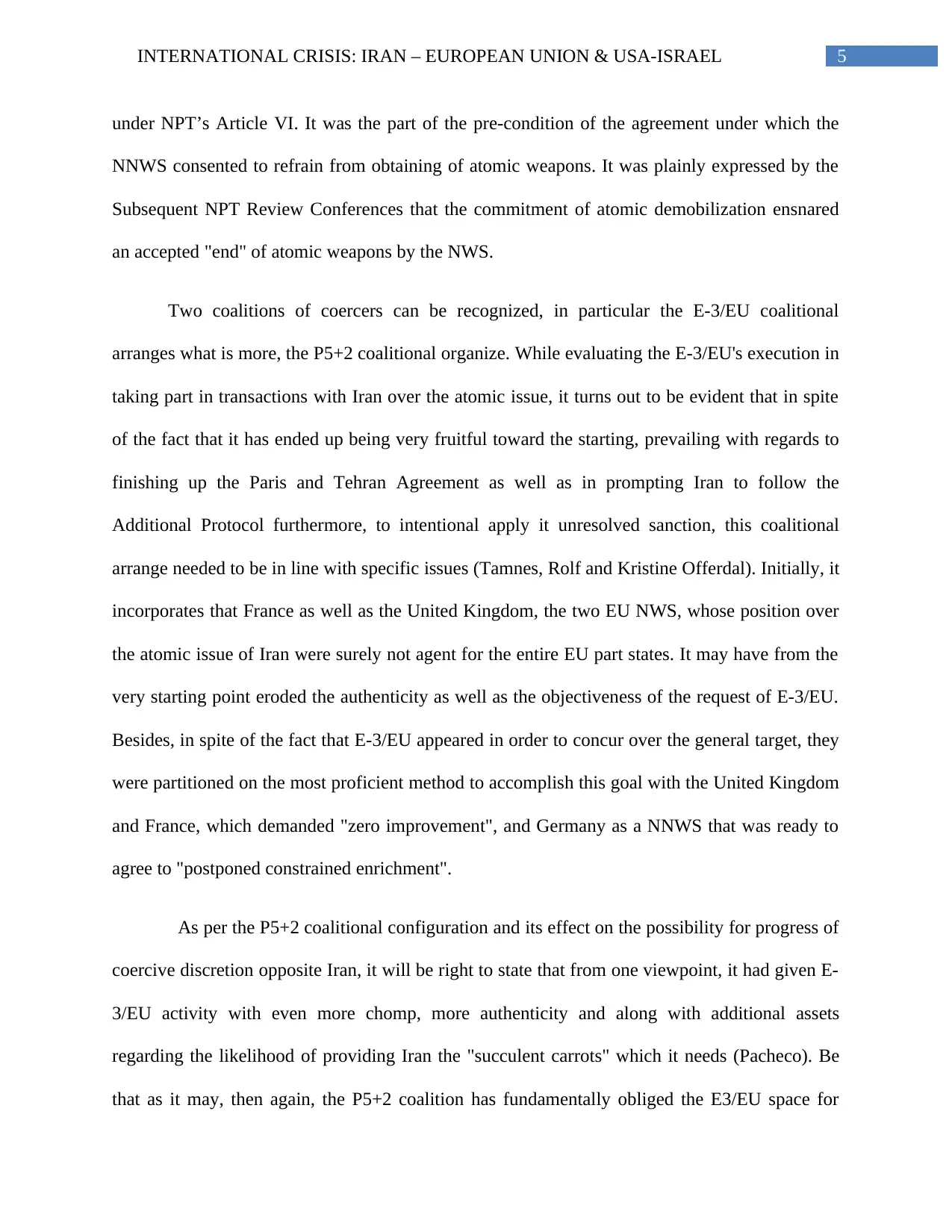
5INTERNATIONAL CRISIS: IRAN – EUROPEAN UNION & USA-ISRAEL
under NPT’s Article VI. It was the part of the pre-condition of the agreement under which the
NNWS consented to refrain from obtaining of atomic weapons. It was plainly expressed by the
Subsequent NPT Review Conferences that the commitment of atomic demobilization ensnared
an accepted "end" of atomic weapons by the NWS.
Two coalitions of coercers can be recognized, in particular the E-3/EU coalitional
arranges what is more, the P5+2 coalitional organize. While evaluating the E-3/EU's execution in
taking part in transactions with Iran over the atomic issue, it turns out to be evident that in spite
of the fact that it has ended up being very fruitful toward the starting, prevailing with regards to
finishing up the Paris and Tehran Agreement as well as in prompting Iran to follow the
Additional Protocol furthermore, to intentional apply it unresolved sanction, this coalitional
arrange needed to be in line with specific issues (Tamnes, Rolf and Kristine Offerdal). Initially, it
incorporates that France as well as the United Kingdom, the two EU NWS, whose position over
the atomic issue of Iran were surely not agent for the entire EU part states. It may have from the
very starting point eroded the authenticity as well as the objectiveness of the request of E-3/EU.
Besides, in spite of the fact that E-3/EU appeared in order to concur over the general target, they
were partitioned on the most proficient method to accomplish this goal with the United Kingdom
and France, which demanded "zero improvement", and Germany as a NNWS that was ready to
agree to "postponed constrained enrichment".
As per the P5+2 coalitional configuration and its effect on the possibility for progress of
coercive discretion opposite Iran, it will be right to state that from one viewpoint, it had given E-
3/EU activity with even more chomp, more authenticity and along with additional assets
regarding the likelihood of providing Iran the "succulent carrots" which it needs (Pacheco). Be
that as it may, then again, the P5+2 coalition has fundamentally obliged the E3/EU space for
under NPT’s Article VI. It was the part of the pre-condition of the agreement under which the
NNWS consented to refrain from obtaining of atomic weapons. It was plainly expressed by the
Subsequent NPT Review Conferences that the commitment of atomic demobilization ensnared
an accepted "end" of atomic weapons by the NWS.
Two coalitions of coercers can be recognized, in particular the E-3/EU coalitional
arranges what is more, the P5+2 coalitional organize. While evaluating the E-3/EU's execution in
taking part in transactions with Iran over the atomic issue, it turns out to be evident that in spite
of the fact that it has ended up being very fruitful toward the starting, prevailing with regards to
finishing up the Paris and Tehran Agreement as well as in prompting Iran to follow the
Additional Protocol furthermore, to intentional apply it unresolved sanction, this coalitional
arrange needed to be in line with specific issues (Tamnes, Rolf and Kristine Offerdal). Initially, it
incorporates that France as well as the United Kingdom, the two EU NWS, whose position over
the atomic issue of Iran were surely not agent for the entire EU part states. It may have from the
very starting point eroded the authenticity as well as the objectiveness of the request of E-3/EU.
Besides, in spite of the fact that E-3/EU appeared in order to concur over the general target, they
were partitioned on the most proficient method to accomplish this goal with the United Kingdom
and France, which demanded "zero improvement", and Germany as a NNWS that was ready to
agree to "postponed constrained enrichment".
As per the P5+2 coalitional configuration and its effect on the possibility for progress of
coercive discretion opposite Iran, it will be right to state that from one viewpoint, it had given E-
3/EU activity with even more chomp, more authenticity and along with additional assets
regarding the likelihood of providing Iran the "succulent carrots" which it needs (Pacheco). Be
that as it may, then again, the P5+2 coalition has fundamentally obliged the E3/EU space for
⊘ This is a preview!⊘
Do you want full access?
Subscribe today to unlock all pages.

Trusted by 1+ million students worldwide
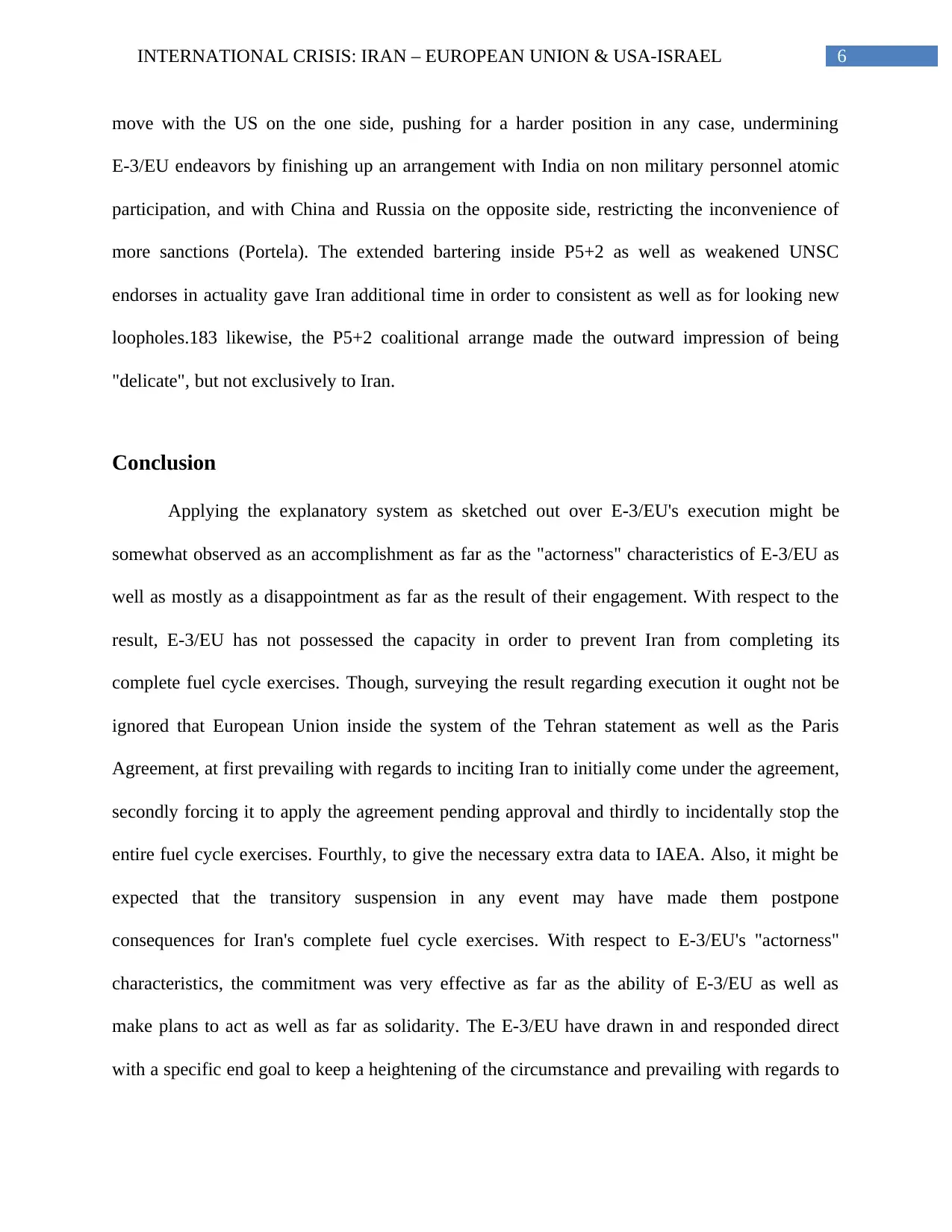
6INTERNATIONAL CRISIS: IRAN – EUROPEAN UNION & USA-ISRAEL
move with the US on the one side, pushing for a harder position in any case, undermining
E-3/EU endeavors by finishing up an arrangement with India on non military personnel atomic
participation, and with China and Russia on the opposite side, restricting the inconvenience of
more sanctions (Portela). The extended bartering inside P5+2 as well as weakened UNSC
endorses in actuality gave Iran additional time in order to consistent as well as for looking new
loopholes.183 likewise, the P5+2 coalitional arrange made the outward impression of being
"delicate", but not exclusively to Iran.
Conclusion
Applying the explanatory system as sketched out over E-3/EU's execution might be
somewhat observed as an accomplishment as far as the "actorness" characteristics of E-3/EU as
well as mostly as a disappointment as far as the result of their engagement. With respect to the
result, E-3/EU has not possessed the capacity in order to prevent Iran from completing its
complete fuel cycle exercises. Though, surveying the result regarding execution it ought not be
ignored that European Union inside the system of the Tehran statement as well as the Paris
Agreement, at first prevailing with regards to inciting Iran to initially come under the agreement,
secondly forcing it to apply the agreement pending approval and thirdly to incidentally stop the
entire fuel cycle exercises. Fourthly, to give the necessary extra data to IAEA. Also, it might be
expected that the transitory suspension in any event may have made them postpone
consequences for Iran's complete fuel cycle exercises. With respect to E-3/EU's "actorness"
characteristics, the commitment was very effective as far as the ability of E-3/EU as well as
make plans to act as well as far as solidarity. The E-3/EU have drawn in and responded direct
with a specific end goal to keep a heightening of the circumstance and prevailing with regards to
move with the US on the one side, pushing for a harder position in any case, undermining
E-3/EU endeavors by finishing up an arrangement with India on non military personnel atomic
participation, and with China and Russia on the opposite side, restricting the inconvenience of
more sanctions (Portela). The extended bartering inside P5+2 as well as weakened UNSC
endorses in actuality gave Iran additional time in order to consistent as well as for looking new
loopholes.183 likewise, the P5+2 coalitional arrange made the outward impression of being
"delicate", but not exclusively to Iran.
Conclusion
Applying the explanatory system as sketched out over E-3/EU's execution might be
somewhat observed as an accomplishment as far as the "actorness" characteristics of E-3/EU as
well as mostly as a disappointment as far as the result of their engagement. With respect to the
result, E-3/EU has not possessed the capacity in order to prevent Iran from completing its
complete fuel cycle exercises. Though, surveying the result regarding execution it ought not be
ignored that European Union inside the system of the Tehran statement as well as the Paris
Agreement, at first prevailing with regards to inciting Iran to initially come under the agreement,
secondly forcing it to apply the agreement pending approval and thirdly to incidentally stop the
entire fuel cycle exercises. Fourthly, to give the necessary extra data to IAEA. Also, it might be
expected that the transitory suspension in any event may have made them postpone
consequences for Iran's complete fuel cycle exercises. With respect to E-3/EU's "actorness"
characteristics, the commitment was very effective as far as the ability of E-3/EU as well as
make plans to act as well as far as solidarity. The E-3/EU have drawn in and responded direct
with a specific end goal to keep a heightening of the circumstance and prevailing with regards to
Paraphrase This Document
Need a fresh take? Get an instant paraphrase of this document with our AI Paraphraser
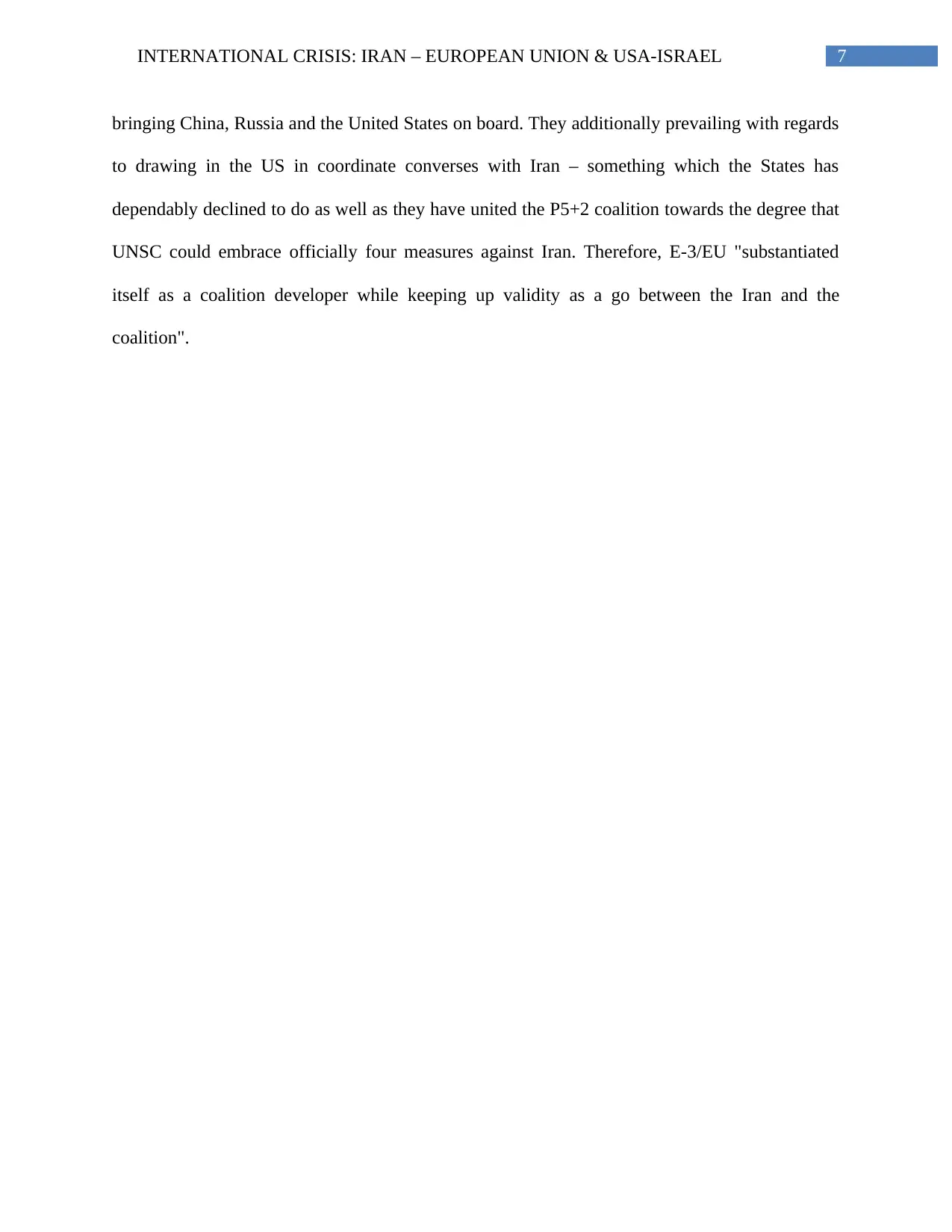
7INTERNATIONAL CRISIS: IRAN – EUROPEAN UNION & USA-ISRAEL
bringing China, Russia and the United States on board. They additionally prevailing with regards
to drawing in the US in coordinate converses with Iran – something which the States has
dependably declined to do as well as they have united the P5+2 coalition towards the degree that
UNSC could embrace officially four measures against Iran. Therefore, E-3/EU "substantiated
itself as a coalition developer while keeping up validity as a go between the Iran and the
coalition".
bringing China, Russia and the United States on board. They additionally prevailing with regards
to drawing in the US in coordinate converses with Iran – something which the States has
dependably declined to do as well as they have united the P5+2 coalition towards the degree that
UNSC could embrace officially four measures against Iran. Therefore, E-3/EU "substantiated
itself as a coalition developer while keeping up validity as a go between the Iran and the
coalition".
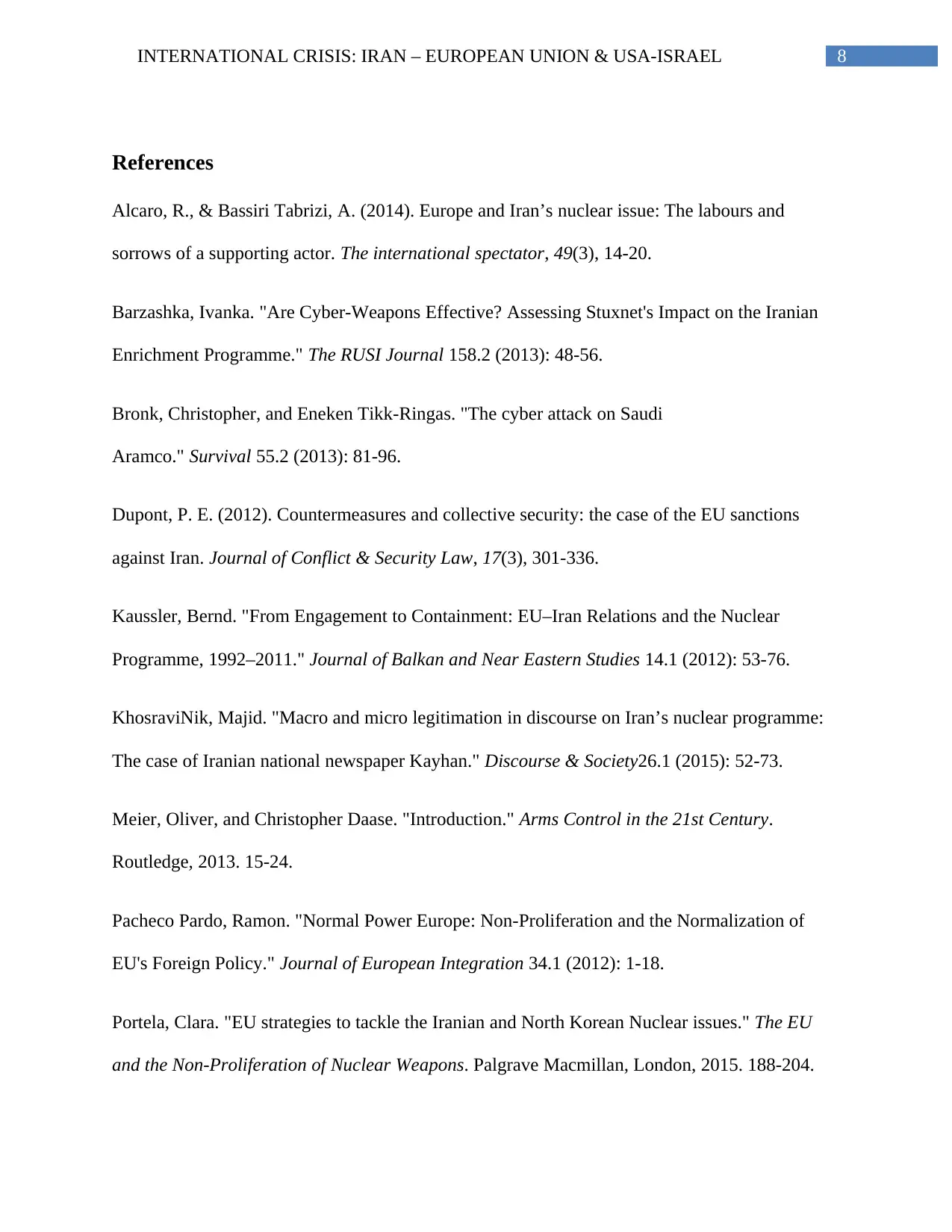
8INTERNATIONAL CRISIS: IRAN – EUROPEAN UNION & USA-ISRAEL
References
Alcaro, R., & Bassiri Tabrizi, A. (2014). Europe and Iran’s nuclear issue: The labours and
sorrows of a supporting actor. The international spectator, 49(3), 14-20.
Barzashka, Ivanka. "Are Cyber-Weapons Effective? Assessing Stuxnet's Impact on the Iranian
Enrichment Programme." The RUSI Journal 158.2 (2013): 48-56.
Bronk, Christopher, and Eneken Tikk-Ringas. "The cyber attack on Saudi
Aramco." Survival 55.2 (2013): 81-96.
Dupont, P. E. (2012). Countermeasures and collective security: the case of the EU sanctions
against Iran. Journal of Conflict & Security Law, 17(3), 301-336.
Kaussler, Bernd. "From Engagement to Containment: EU–Iran Relations and the Nuclear
Programme, 1992–2011." Journal of Balkan and Near Eastern Studies 14.1 (2012): 53-76.
KhosraviNik, Majid. "Macro and micro legitimation in discourse on Iran’s nuclear programme:
The case of Iranian national newspaper Kayhan." Discourse & Society26.1 (2015): 52-73.
Meier, Oliver, and Christopher Daase. "Introduction." Arms Control in the 21st Century.
Routledge, 2013. 15-24.
Pacheco Pardo, Ramon. "Normal Power Europe: Non-Proliferation and the Normalization of
EU's Foreign Policy." Journal of European Integration 34.1 (2012): 1-18.
Portela, Clara. "EU strategies to tackle the Iranian and North Korean Nuclear issues." The EU
and the Non-Proliferation of Nuclear Weapons. Palgrave Macmillan, London, 2015. 188-204.
References
Alcaro, R., & Bassiri Tabrizi, A. (2014). Europe and Iran’s nuclear issue: The labours and
sorrows of a supporting actor. The international spectator, 49(3), 14-20.
Barzashka, Ivanka. "Are Cyber-Weapons Effective? Assessing Stuxnet's Impact on the Iranian
Enrichment Programme." The RUSI Journal 158.2 (2013): 48-56.
Bronk, Christopher, and Eneken Tikk-Ringas. "The cyber attack on Saudi
Aramco." Survival 55.2 (2013): 81-96.
Dupont, P. E. (2012). Countermeasures and collective security: the case of the EU sanctions
against Iran. Journal of Conflict & Security Law, 17(3), 301-336.
Kaussler, Bernd. "From Engagement to Containment: EU–Iran Relations and the Nuclear
Programme, 1992–2011." Journal of Balkan and Near Eastern Studies 14.1 (2012): 53-76.
KhosraviNik, Majid. "Macro and micro legitimation in discourse on Iran’s nuclear programme:
The case of Iranian national newspaper Kayhan." Discourse & Society26.1 (2015): 52-73.
Meier, Oliver, and Christopher Daase. "Introduction." Arms Control in the 21st Century.
Routledge, 2013. 15-24.
Pacheco Pardo, Ramon. "Normal Power Europe: Non-Proliferation and the Normalization of
EU's Foreign Policy." Journal of European Integration 34.1 (2012): 1-18.
Portela, Clara. "EU strategies to tackle the Iranian and North Korean Nuclear issues." The EU
and the Non-Proliferation of Nuclear Weapons. Palgrave Macmillan, London, 2015. 188-204.
⊘ This is a preview!⊘
Do you want full access?
Subscribe today to unlock all pages.

Trusted by 1+ million students worldwide
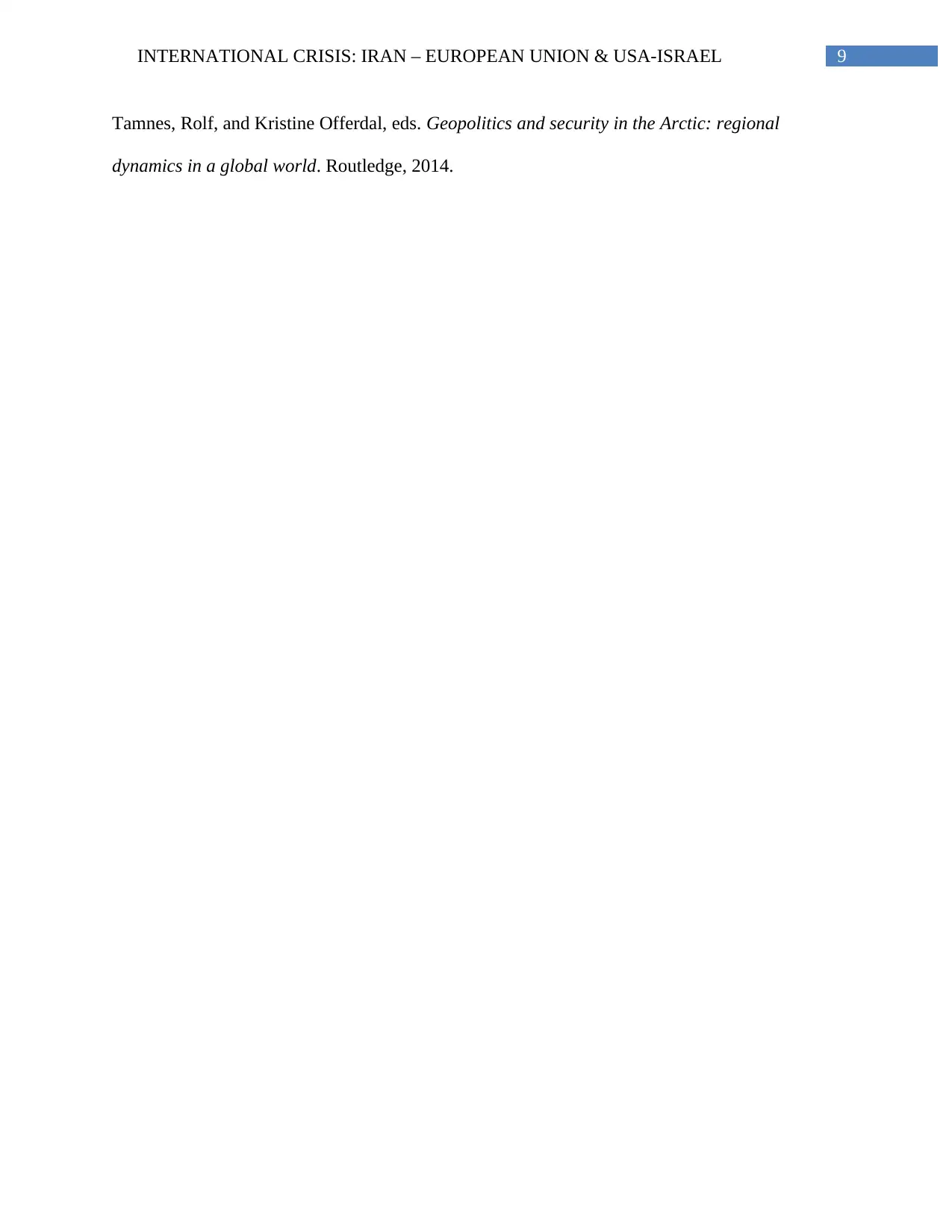
9INTERNATIONAL CRISIS: IRAN – EUROPEAN UNION & USA-ISRAEL
Tamnes, Rolf, and Kristine Offerdal, eds. Geopolitics and security in the Arctic: regional
dynamics in a global world. Routledge, 2014.
Tamnes, Rolf, and Kristine Offerdal, eds. Geopolitics and security in the Arctic: regional
dynamics in a global world. Routledge, 2014.
1 out of 10
Related Documents
Your All-in-One AI-Powered Toolkit for Academic Success.
+13062052269
info@desklib.com
Available 24*7 on WhatsApp / Email
![[object Object]](/_next/static/media/star-bottom.7253800d.svg)
Unlock your academic potential
Copyright © 2020–2025 A2Z Services. All Rights Reserved. Developed and managed by ZUCOL.



